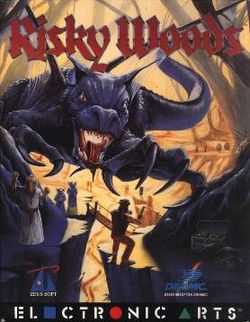Risky Woods
| Risky Woods | |
|---|---|
 Cover art | |
| Developer(s) | Dinamic Software, Zeus Software |
| Publisher(s) | Electronic Arts |
| Platform(s) | Amiga, Atari ST, MS-DOS, Sega Mega Drive/Genesis |
| Release date(s) | 1992 |
| Genre(s) | Side-scroller |
| Mode(s) | Single-player |
Risky Woods, known as Jashin Draxos (邪神ドラクソス Evil God Draxos) in Japan, is a computer game developed by Dinamic Software and Zeus Software, and published by Electronic Arts in December 1992. Its release marks the end of the Golden Era of Spanish Software. The game has a side-scroll view, and a fantasy theme. The game has been criticized as being relatively difficult and being somewhat chaotic in terms of how much is happening on-screen.
Story
The ancient monks, who preserve the wisdom of the Lost Lands, have been frozen in stone. Young Rohan must plunge into the Risky Woods to release them. Only then can wisdom triumph once again.
Gameplay
Most of Risky Woods involves Rohan running, jumping ledges and fighting monsters while freeing the monks from stone. At every third stage lay a boss, usually some gigantic floating insect that throws fireballs. Both the monsters in the levels as well as these insect bosses drop coins, though bosses drop considerably more. These coins can be used after each level to buy weaponry upgrades and extra life energy.
During the game, a number of other elements present themselves, such as evil monks who were also trapped in stone. Freeing them will cost you and even hurt you; they can be distinguished from regular stone monks by how their stone looks. However, some later levels switch which monks are trapped in what color of statue, which can be quite disorienting at first.
The secondary objective of each level is to pass through multiple "Eye-Key" gates. The player has two find two halves of an Eye-Key object, then use the completed Eye-Key to pass through these gates, otherwise the gate will send the player back in the level to find the missing key again, at the cost of half the player's life energy.
Continues may be found during the game, but only two are given in the entirety of the game. Once those continues are used up, that's game over and the player has to restart the game. The final level leads to a castle in which we must defeat Draxos, and upon which we are given a short animation and game over sequence.
Mega Drive Version
The Mega Drive/Genesis version of the game is considerably different from all other ports. While maintaining the core gameplay and keeping the stages of the original version of the game, this version of Risky Woods changes a few things around:
- Rohan's portrait is no longer shown in the lower-right corner with his energy meter. Instead, boss portraits are shown there with their life meter underneath.
- Rohan is no longer in traveler's gear. Rather, he himself appears as a priest in a robe carrying a staff. Despite this, he still uses knives, boomerangs, and the usual assortment of weapons, but they now drop from gargoyle statues.
- Shoppes have been completely removed from the game. As such, coins now serve a different purpose in the game. At 33 coins, the player is awarded battle armor which reduces damage taken by roughly half. At 66 coins, the armor is upgraded to golden armor which nullifies damage entirely, though Rohan will still get bounced if hit. The armor can be lost by simply being hit too many times or falling into too many pits, both of which shake loose coins Rohan has collected.
- Eye-Key pillars are now stone gargoyles with whom you must play a memory game with; match the arrow sequence to destroy them.
- Rohan can no longer clear the screen any time he wants to once he has a complete gate token.
- However, using a gate key with a gargoyle statue does clear the screen still.
- As a result of the change to the gate token, Skulls are no longer potential hazards, but rather smart bomb power-ups.
- In the original game, Rohan would throw the gate token and clear all enemies on-screen. In this version, he uses his staff in three different ways, depending on his armor, though each ends up clearing the screen of enemies in its own way.
- If you run out of time in a level, you restart that level with the exact stats you had when you entered the level. This includes coins, health, Skulls, and lives. Losing all your lives will still result in a game over, however.
- The ending sequence is slightly more interesting in this version.
All and all, the Mega Drive version of the game is much easier than any of the three other ports due to the changes made as well as other minor changes to levels. It is otherwise entirely faithful to the original game.